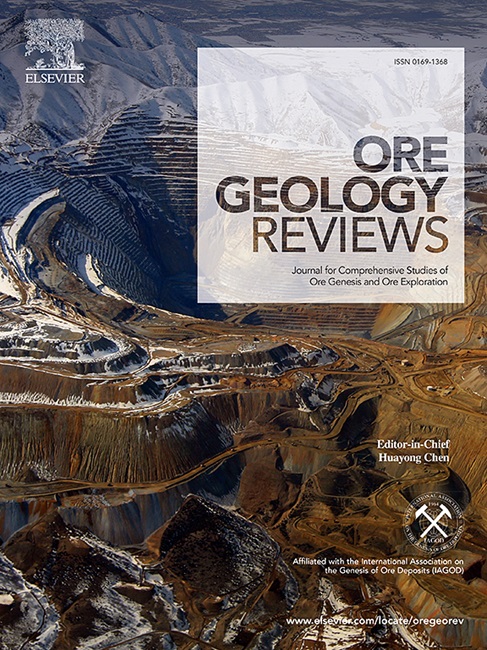Characteristics of ore-forming fluid and sources of ore-forming material in the Yangzhaiyu gold deposit, Xiaoqinling gold district
IF 3.2
2区 地球科学
Q1 GEOLOGY
引用次数: 0
Abstract
The Yangzhaiyu deposit is a large lode gold deposit in the Xiaoqinling region, along the southern margin of North China Craton, and it occurs mainly in the deep metamorphic gneiss series of the Taihua Supergroup. Researches based on petrography, micro-thermometry and Laser Raman analysis suggest that the homogenization temperature of ore-forming fluid was 216–346 ℃, the salinity was 6–8.7 %, with corresponding average density of 0.72–0.9 g/cm3. The ore-forming fluid was medium–high temperature, low salinity, CO2-rich, and belonged to the CO2–H2O–NaCl system. From stages I to IV, the metallogenic temperature, salinity and pressure showed a decreasing trend. Fluid immiscibility may be the precipitation mechanism of native gold in the Yangzhaiyu gold deposit. The H–O isotopic values of fluids (δDH2O = – 61 to – 51.8 ‰, δ18OH2O = 2.7 to 6.9 ‰) in stage I to IV suggest that the ore-forming hydrothermal fluid may have been a multi-source mixed hydrothermal fluid such as metamorphic water, magmatic water and meteoric water, which was mainly derived from metamorphic water and magmatic water, meteoric water gradually added with the mineralization process. The He–Ar isotopic values of fluids (3He/4He = 0.63–1.2 Ra,40Ar/36Ar = 3978.6–5044.9) in stage I to IV suggest that the ore-forming fluid was a mixture of mantle source and crust source, mainly crustal source helium. With the progress of mineralization, the proportion of mantle source helium in the ore-forming fluid gradually decreases. The S isotopic values of sulfide (δ34SV-CDT = – 3.7 to 4.7 ‰, δ34S∑s = – 5.4 to 4.5 ‰) in stage I to IV suggest that δ34S consistent with the characteristics of mantle-derived sulfur and the ore-forming sulfur may come from the Taihua Supergroup. The Pb isotopic values of sulfide (206Pb/204Pb = 17.015–17.158, 207Pb/204Pb = 15.394–15.524, 208Pb/204Pb = 37.481–37.91) in stage I to IV suggest that the ore-forming fluid was deep source mixed Pb from the mantle and the crust. The source of Pb in the deposit could be the Taihua Supergroup. The main mechanism of ore-forming fluid evolution was that the deep-source ore-forming fluid produced by crust-mantle interaction mixed with metamorphic hydrothermal fluid, meteoric water and other source fluids during upward migration in multiple stages during the whole ore-forming period. According to the geological, tectonic environment, fluid inclusions and isotopic data, combined with previous studies, the Yangzhaiyu gold deposit is considered as an orogenic gold deposit.

求助全文
约1分钟内获得全文
求助全文
来源期刊

Ore Geology Reviews
地学-地质学
CiteScore
6.50
自引率
27.30%
发文量
546
审稿时长
22.9 weeks
期刊介绍:
Ore Geology Reviews aims to familiarize all earth scientists with recent advances in a number of interconnected disciplines related to the study of, and search for, ore deposits. The reviews range from brief to longer contributions, but the journal preferentially publishes manuscripts that fill the niche between the commonly shorter journal articles and the comprehensive book coverages, and thus has a special appeal to many authors and readers.
 求助内容:
求助内容: 应助结果提醒方式:
应助结果提醒方式:


